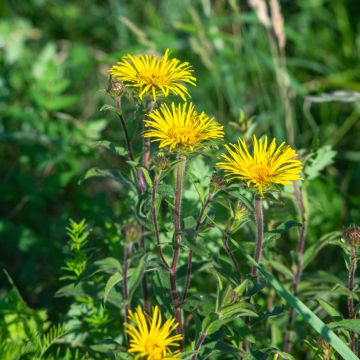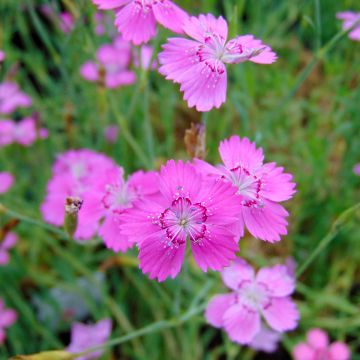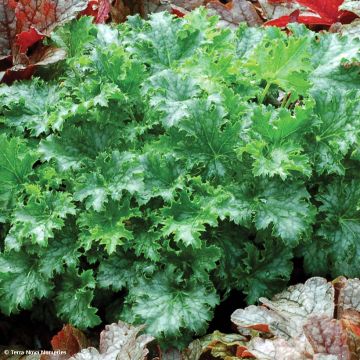

Inula helenium


Inula helenium


Inula helenium
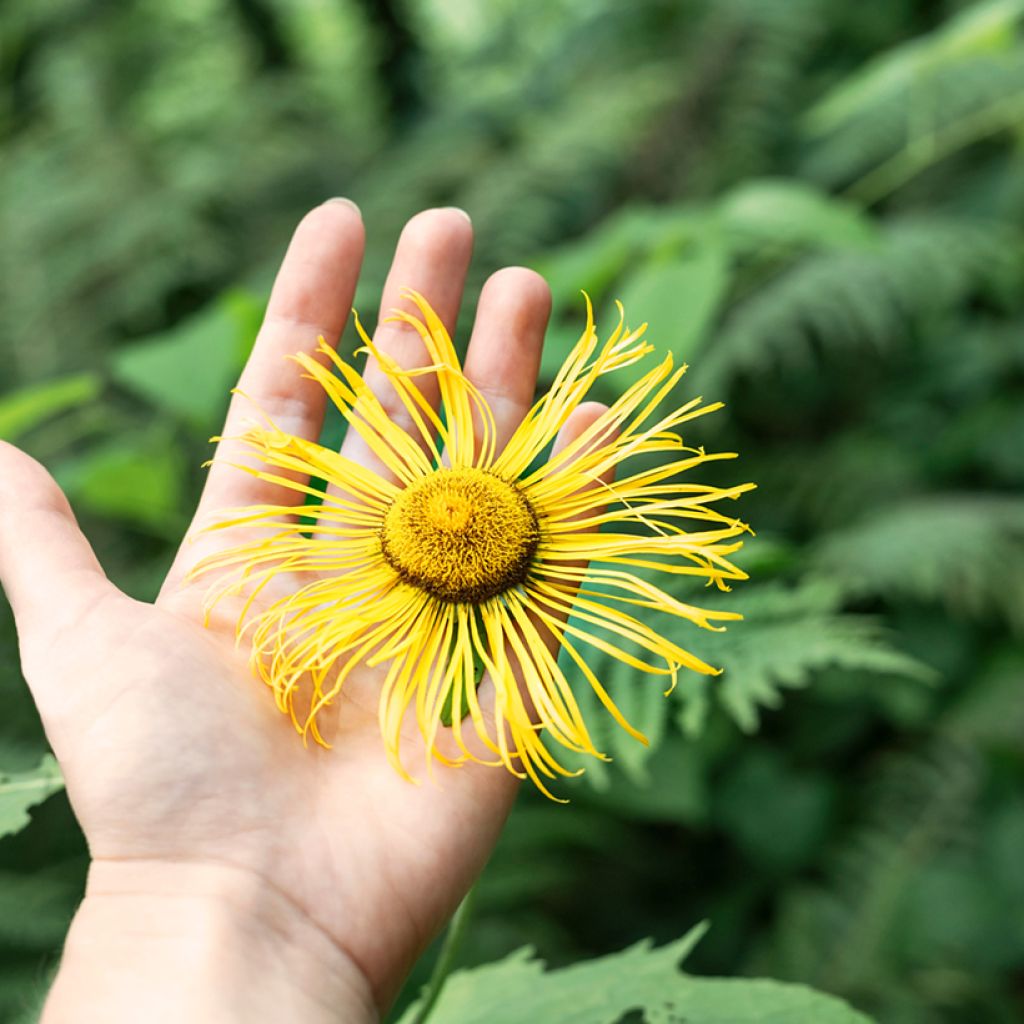

Inula helenium
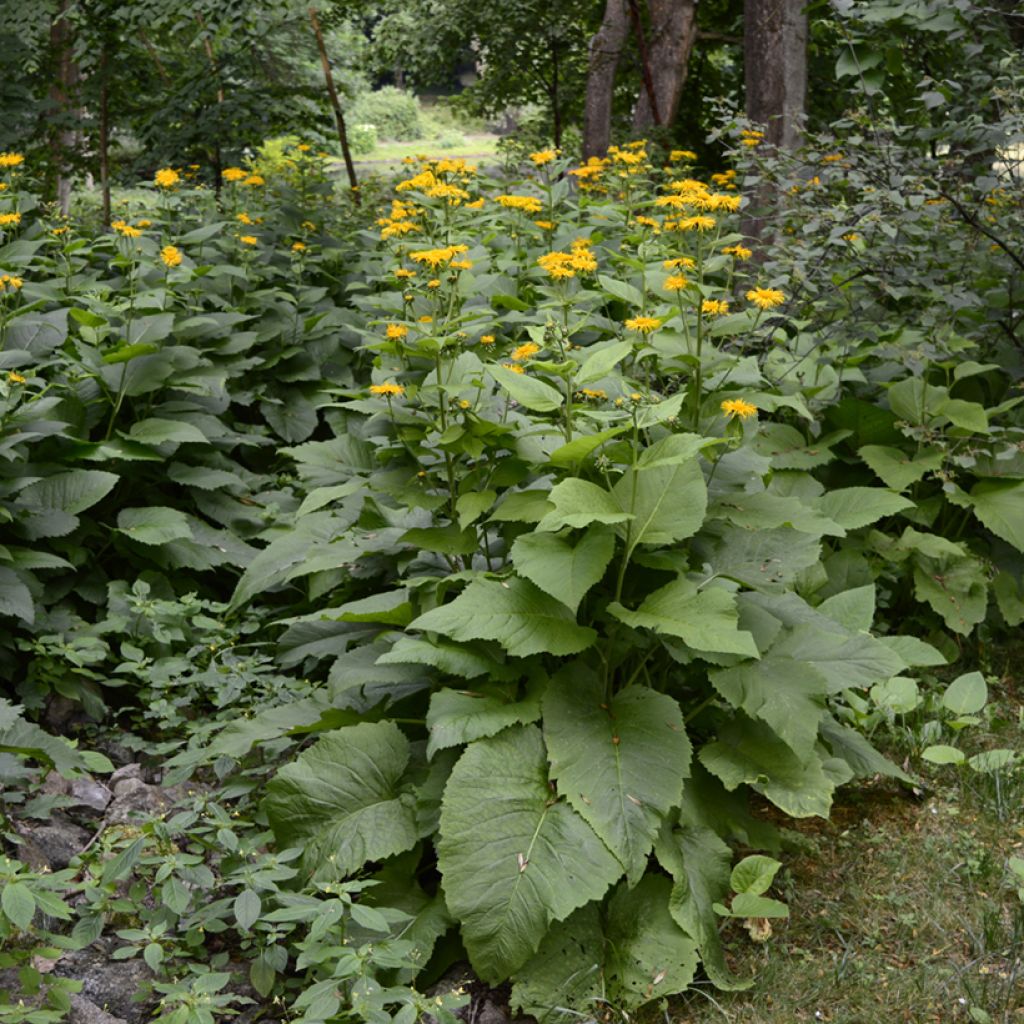

Inula helenium


Inula helenium


Inula helenium


Inula helenium


Inula helenium
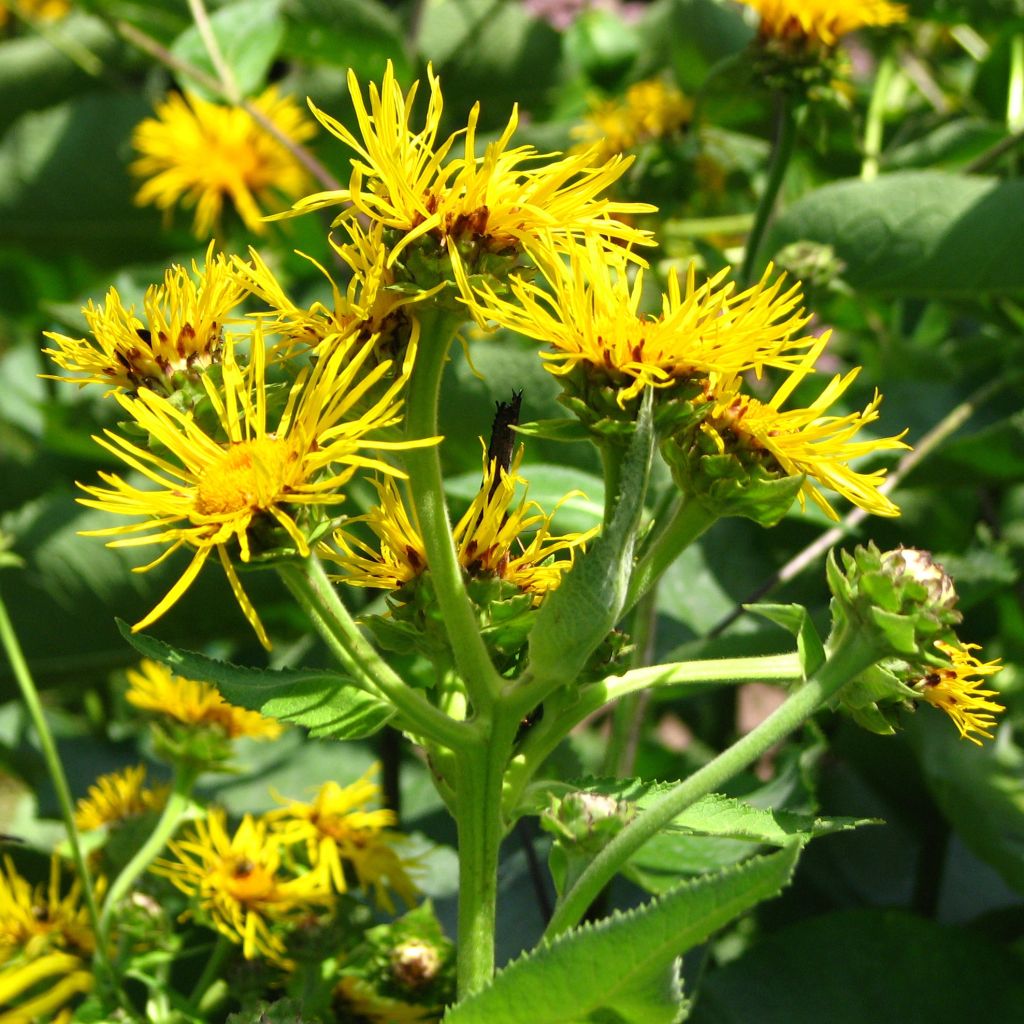

Inula helenium


Inula helenium
Inula helenium
Inula helenium
Elecampane, Elf Dock, Elf Wort, Else dock, Yellow Starwort
Really spectacular young plant but slow to establish. I had to wait 3 years before it showed all its tiller potential.
Josiane, 04/02/2022
This item cannot be shipped to the selected country
Delivery charge from €5.90
More information
Schedule delivery date,
and select date in basket
This plant carries a 12 months recovery warranty
More information
We guarantee the quality of our plants for a full growing cycle, and will replace at our expense any plant that fails to recover under normal climatic and planting conditions.
From €5.90 for pickup delivery and €6.90 for home delivery
Express home delivery from €8.90.
Does this plant fit my garden?
Set up your Plantfit profile →
Description
Inula helenium, or Elecampane, is a hardy perennial with a wild appearance. Thanks to its imposing size and large leaves, it generously occupies space and creates a lush vegetal screen. Its flowering takes place from July to August, brightening up the summer with the dance of pollinators that land on the large yellow flowers with delicate and slightly tousled petals.
Originally from Asia, Inula helenium has spread to Europe. It thrives in damp meadows and on the edges of woodlands. Therefore, it appreciates moist soils. Quite hardy, it withstands frost down to about -15°C (5°F), tolerates all types of soil, and prefers a sunny or partially shaded exposure. From its large rhizomatous stump, robust and pubescent stems emerge, reaching up to 1.5m (5ft) or more. These stems bear heads with a diameter of at least 5cm (2in). They consist of a large yellow heart that attracts insects and is surrounded by a row of extremely delicate florets, giving it a wild and tousled appearance. In autumn, silky achenes with plumes appear and scatter in the wind, settling everywhere. Its deciduous foliage is very present. The stump is covered with large, deeply veined, and wavy-edged leaves with a cottony, greyish-green underside. They alternate along the stem, are sessile, and become smaller as they approach the top.
Elecampane is an easy and hardy perennial that deserves to be rediscovered in our gardens. As a background plant, it forms a voluminous backdrop that can act as a screen and blend well with all the wild-looking giants: goat's beard, mugwort, meadowsweet, and goldenrod. This combination guarantees an effect with minimal maintenance. If you have a smaller garden, it can be placed as a solitary plant and will be captivating on its own.
Elecampane has been known for centuries for its numerous medicinal properties, as well as veterinary uses. The list is endless: tonic, diuretic, antitussive, febrifuge, and many more. Its rhizomes and heads are used dried, ground, in herbal tea, and in oil. The uses are multiple, including in cooking. But beware! Precautions are necessary, as some people may not tolerate its effects.
Report an error about the product description
Inula helenium in pictures


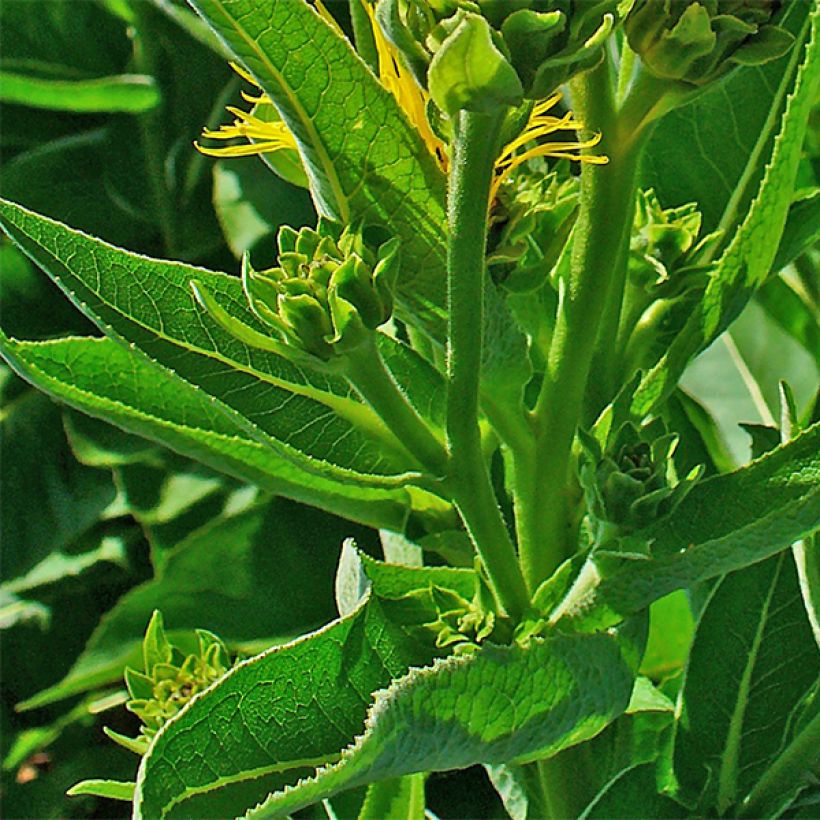



Flowering
Foliage
Plant habit
Botanical data
Inula
helenium
Asteraceae
Elecampane, Elf Dock, Elf Wort, Else dock, Yellow Starwort
Central Europe
Other Inula
Planting and care
Inula helenium gives its best in moist, deep, and rich soil under a sunny exposure. However, it also tolerates limestone soil and a semi-shaded exposure.
If you wish to plant it in heavy soil, add some gravel to drain the bottom of the hole, as it doesn't appreciate waterlogged soil.
Don't forget its habit (up to 90cm (35in) wide) and leave some space around it so that it can spread as it wishes. It will only become more beautiful and generous.
Planting period
Intended location
Care
-
, onOrder confirmed
Reply from on Promesse de fleurs
Summer flowering perennials
Haven't found what you were looking for?
Hardiness is the lowest winter temperature a plant can endure without suffering serious damage or even dying. However, hardiness is affected by location (a sheltered area, such as a patio), protection (winter cover) and soil type (hardiness is improved by well-drained soil).

Photo Sharing Terms & Conditions
In order to encourage gardeners to interact and share their experiences, Promesse de fleurs offers various media enabling content to be uploaded onto its Site - in particular via the ‘Photo sharing’ module.
The User agrees to refrain from:
- Posting any content that is illegal, prejudicial, insulting, racist, inciteful to hatred, revisionist, contrary to public decency, that infringes on privacy or on the privacy rights of third parties, in particular the publicity rights of persons and goods, intellectual property rights, or the right to privacy.
- Submitting content on behalf of a third party;
- Impersonate the identity of a third party and/or publish any personal information about a third party;
In general, the User undertakes to refrain from any unethical behaviour.
All Content (in particular text, comments, files, images, photos, videos, creative works, etc.), which may be subject to property or intellectual property rights, image or other private rights, shall remain the property of the User, subject to the limited rights granted by the terms of the licence granted by Promesse de fleurs as stated below. Users are at liberty to publish or not to publish such Content on the Site, notably via the ‘Photo Sharing’ facility, and accept that this Content shall be made public and freely accessible, notably on the Internet.
Users further acknowledge, undertake to have ,and guarantee that they hold all necessary rights and permissions to publish such material on the Site, in particular with regard to the legislation in force pertaining to any privacy, property, intellectual property, image, or contractual rights, or rights of any other nature. By publishing such Content on the Site, Users acknowledge accepting full liability as publishers of the Content within the meaning of the law, and grant Promesse de fleurs, free of charge, an inclusive, worldwide licence for the said Content for the entire duration of its publication, including all reproduction, representation, up/downloading, displaying, performing, transmission, and storage rights.
Users also grant permission for their name to be linked to the Content and accept that this link may not always be made available.
By engaging in posting material, Users consent to their Content becoming automatically accessible on the Internet, in particular on other sites and/or blogs and/or web pages of the Promesse de fleurs site, including in particular social pages and the Promesse de fleurs catalogue.
Users may secure the removal of entrusted content free of charge by issuing a simple request via our contact form.
The flowering period indicated on our website applies to countries and regions located in USDA zone 8 (France, the United Kingdom, Ireland, the Netherlands, etc.)
It will vary according to where you live:
- In zones 9 to 10 (Italy, Spain, Greece, etc.), flowering will occur about 2 to 4 weeks earlier.
- In zones 6 to 7 (Germany, Poland, Slovenia, and lower mountainous regions), flowering will be delayed by 2 to 3 weeks.
- In zone 5 (Central Europe, Scandinavia), blooming will be delayed by 3 to 5 weeks.
In temperate climates, pruning of spring-flowering shrubs (forsythia, spireas, etc.) should be done just after flowering.
Pruning of summer-flowering shrubs (Indian Lilac, Perovskia, etc.) can be done in winter or spring.
In cold regions as well as with frost-sensitive plants, avoid pruning too early when severe frosts may still occur.
The planting period indicated on our website applies to countries and regions located in USDA zone 8 (France, United Kingdom, Ireland, Netherlands).
It will vary according to where you live:
- In Mediterranean zones (Marseille, Madrid, Milan, etc.), autumn and winter are the best planting periods.
- In continental zones (Strasbourg, Munich, Vienna, etc.), delay planting by 2 to 3 weeks in spring and bring it forward by 2 to 4 weeks in autumn.
- In mountainous regions (the Alps, Pyrenees, Carpathians, etc.), it is best to plant in late spring (May-June) or late summer (August-September).
The harvesting period indicated on our website applies to countries and regions in USDA zone 8 (France, England, Ireland, the Netherlands).
In colder areas (Scandinavia, Poland, Austria...) fruit and vegetable harvests are likely to be delayed by 3-4 weeks.
In warmer areas (Italy, Spain, Greece, etc.), harvesting will probably take place earlier, depending on weather conditions.
The sowing periods indicated on our website apply to countries and regions within USDA Zone 8 (France, UK, Ireland, Netherlands).
In colder areas (Scandinavia, Poland, Austria...), delay any outdoor sowing by 3-4 weeks, or sow under glass.
In warmer climes (Italy, Spain, Greece, etc.), bring outdoor sowing forward by a few weeks.


































